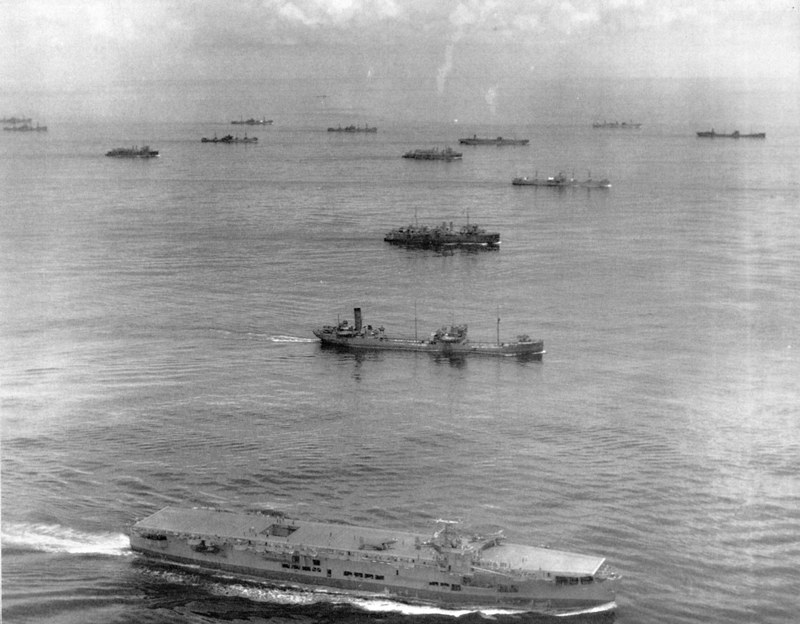
“The only thing that ever really frightened me was the U-boat peril. Never for one minute could we forget that everything happening elsewhere – on land, at sea and in the air – ultimately depended on its outcome, and amid all other cares, we viewed all its changing fortunes day by day with hope and apprehension.” – Winston Churchill
The Atlantic, scene of many decisive battles in past centuries, became the central objective for opposing alliances in the twentieth century. In April 1917 the British Admiralty admitted that “unless the appalling destruction of merchant tonnage which was then taking place could be materially checked, the unconditional surrender of the British Empire would inevitably take place within a few months.” The introduction of convoys, and new tactical innovations that, for instance, applied airpower to the anti-submarine effort, overcame that crisis. Once shipping losses fell below the critical point, and the Allies had been strengthened by the entrance of the United States into the war, it was possible to stop the onslaught of a severely weakened Germany in 1918.
In the Second World War, because the Allies had been driven off the European continent, and although a massive bombing campaign provided a partial substitute for decisive victory, the American historian Gerhard Weinberg observes: “…if the Allies were to crush Germany, they would have to open a new front on the continent, land and supply vast forces there, and advance into Germany itself. All depended on control of the seas.” The Allies did accomplish the huge strategic achievement of convoying some 43,000 ships, amounting to more than 235 million deadweight tons, across the Atlantic, in the face of unremitting enemy efforts to destroy more tonnage than could be replaced. This would not have been possible without brilliant operational intelligence, the anticipation and defeat of German technological breakthroughs such as magnetic mines, type IX U-boats with snorkel and homing torpedoes. Allied success in countering every new German technology, and in the new and improved application of airpower to the maritime war, combined with the endurance and courage of Allied seamen in the Alllied navies, and especially in merchant ships, where casualties were unmercifully high, defeated the enemy attack on shipping.
In addition, what became known as Royal Air Force (RAF) Ferry Command delivered 10,000 aircraft across the oceans of the world. The value of this, writes its historian, Carl Christie, “… lies as much on the transformation of the Atlantic route, pioneered before the war, into an airway for the mass movement of bombers, reconnaissance aircraft, and transports and the development of the concept of long-range strategic air supply which the Allies employed so effectively in every theatre of war.”
During the Cold War the Atlantic, where fortunately, in view of the major advances in technology that were taking place, hostilities never occurred, both the western and eastern powers continued to give the Atlantic the same strategic importance it had held since the beginning of the century.
Narrative courtesy Dr. W. Alexander Douglas
Eastern Canada
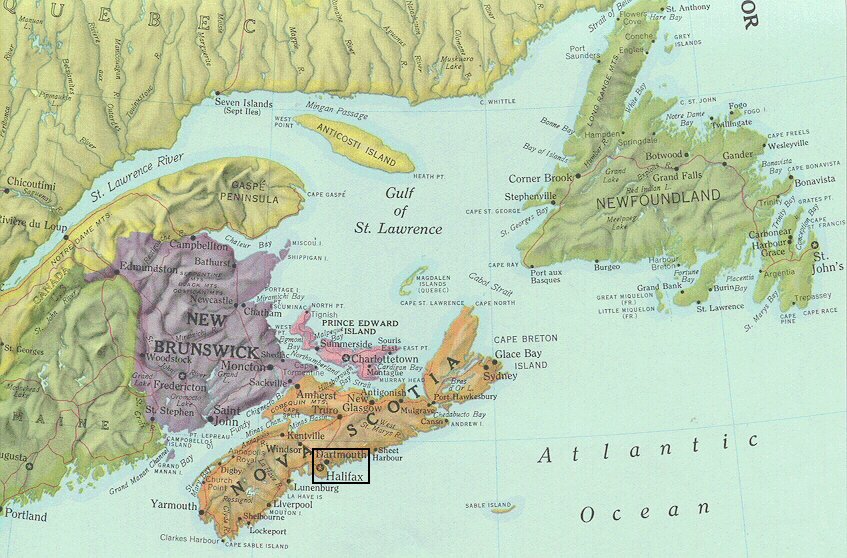
Naval and air bases in the Atlantic provinces, Quebec and Newfoundland played important roles in maritime warfare during the First and Second World Wars and the Cold War. During the First World War, when a German submarine threat materialised, the Royal Canadian Navy provided anti-submarine patrols in the Gulf of St Lawrence and the eastern Atlantic with the modest fleet available, and in 1918 the short-lived Royal Canadian Naval Air Service began operations from Dartmouth, NS. In the Second World War Halifax, St John’s and Argentia, Newfoundland became the principal naval bases in Eastern Canada, supported by ancillary bases in New Brunswick and Cape Breton Island. The Royal Canadian Air Force (RCAF), United States Air Force (USAF) and United States Navy (USN) flew extensive anti-submarine patrols from bases in Quebec, New Brunswick, Nova Scotia, Prince Edward Island and Newfoundland. In 1943 Halifax became the headquarters for the new Canadian Northwest Atlantic theatre. Both coastal and ocean convoys sailed from Quebec, Sydney (Nova Scotia), Halifax (Nova Scotia), St John’s (New Brunswick) and St John’s (Newfoundland). In the Cold War, during the Cuban Missile Crisis of 1962, sea and air anti-submarine operations in co-operation with the USN originated in Halifax, Dartmouth (Nova Scotia), Charlottetown (Prince Edward Island) and Gander (Newfoundland).
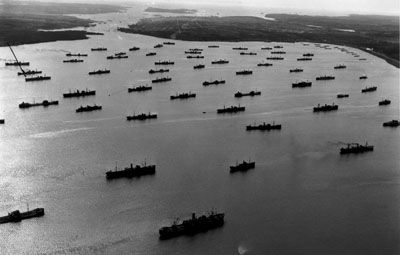
Europe
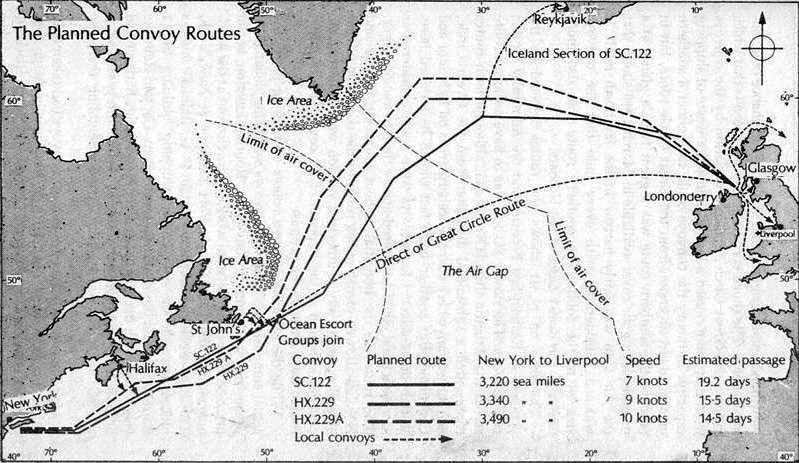
Port of Liverpool
“The port of Liverpool may be said to have been the pivot on which the Allies’ whole European war effort has turned.” – Liverpool Daily Post, September 1, 1944
Liverpool was Britain’s most important port during the war. It handled at least one third of the country’s imports. It was the main terminus for Atlantic trade convoys. By early 1941 it had also become a major naval base and the headquarters of Britain’s North Atlantic campaign. An average of four convoys a week arrived in the Mersey during the war. Between 1939 and 1945 the port of Liverpool handled over 75 million tons of cargo. Almost 74,000 airplanes and gliders were brought into the port. Over 4.7 million troops passed through, of whom 1.2 million were American.
Port of Londonderry
The Port of Londonderry played a vital part for the Allies in World War II during the war’s longest running campaign, the Battle of the Atlantic. From 1942 until the end of the war Londonderry was no less important a base for the Royal Canadian Navy (RCN) than St John’s Newfoundland. As noted in the official history of the RCN, “Canadian sailors in ‘Derry tended to see themselves as ‘nobody’s baby,’ but from late 1943 to the end of the war Canadian naval personnel formed the largest single group of sailors in that port. Five Canadian escort groups, comprising 6,500 men, were using the base. As many as 3000 Canadians were liable to be ashore in the town at any one time. By 1944 there were seventy-five Canadians on Commodore Simpson’s staff, but they were the minority. It was still a British base under British command. From the sailor’s point of view, that did not seem to matter a great deal.”
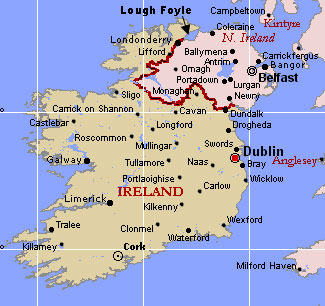
In his memoir War at Sea: A Canadian Seaman On the North Atlantic, Frank Curry recalls:
“…garden-like Loch Foyle [with] countless gardens alive with flowers and lush green grass… was like a dream. The snow and ice of Newfoundland, the winter gales, the heavy grey seas were no more. We were surrounded on both sides with the utter beauty of green Ireland, and it was as if the fairies themselves had wafted us into a land of magic that was almost beyond belief ….It did much to restore our souls, even though we knew we would only have forty-eight hours layover. For those brief hours and days, we would become human beings again; in touch with peace and beauty and tranquility; far removed from all the ugliness of war.”
Narrative courtesy Dr. W. Alexander Douglas
Iceland
Iceland was central to the the defeat of the enemy attack on shipping during the Second World War, and during the Cold War was a significant player in North Atlantic NATO operations and exercises. Canada played an indispensable role in these operations.
There are two main areas of interest in Iceland: Reykjavik and Hvalfjord. During the Second World War Reykjavik was an indispensable port of call for ships involved in the defeat of the enemy attack on shipping, especially from June to December 1941, before Londonderry became their eastern Atlantic terminus, and for Canadian ships escorting arctic convoys. It was also the principal air base for anti-submarine squadrons flying in support of both North Atlantic and Arctic convoys. RCAF 162 (Bomber Reconnaissance) Squadron flying Canso amphibians, was one of the most successful of these squadrons, operating from Reykjavik in 1944-45 and from northern Scotland in the summer of 1944. Flight Lieutenant David Hornell won his VC while the squadron was deployed to this theatre. Hvalfjord was a major fleet anchorage of the most impressive proportions, where the Allies marshalled their forces, both for North Atlantic convoy operations and for ships destined for the Murmansk and Archangel runs. In the Cold War Hvalfjord filled a similar function, and Keflavik, which is now the main international airport in Iceland, was the base for critical air operations in northern waters.
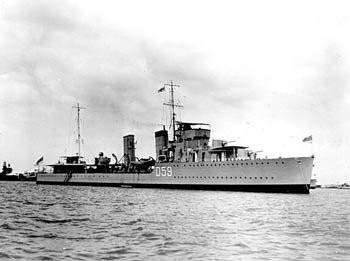
The airport at Keflavik, built during the war, although more remote from the capital was in some ways a better airfield for operations. Most importantly, its runways were not as limited as those at Reykjavik. Postwar, it was used by the Americans and NATO; the Americans left only recently, and there are still structures relating to its Cold War military functions.
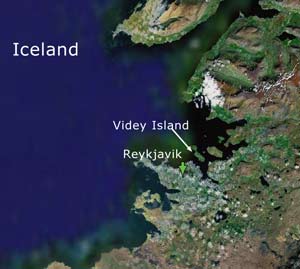
An added point of interest for Canadians is the memorial to HMCS Skeena on Videy island, in Reykjavik harbour. The ship was driven aground in the harbour during a vicious north Atlantic gale in November, 1944. Fifteen men drowned (they are buried in the Commonwealth War Graves Cemetery in Reykjavik) and only through the heroic efforts of several Icelanders were the remainder of the ship’s company brought safely ashore.
Narrative courtesy Dr. W. Alexander Douglas
Murmansk and Archangel
Canadian participation in the so-called Murmansk Run began in November 1943. The Royal Navy had been sending supplies by sea to the USSR since August 1941, sailing at first from Reykjavik and Hvalfjord, and later from Loch Ewe in northern Scotland. In the spring and summer months convoys sailed around Iceland, but in winter the long dark nights and southerly movement of the ice pack forced convoys to take shorter and more dangerous routes about two hundred sea miles closer to German bases in Norway. A heavy drain on the Home Fleet, the Russian convoy cycle had been interrupted during the invasion of North Africa in the fall of 1942, and when ships had to be diverted to the Mediterranean and the mid-Ocean escort force in the spring and summer of 1943. Four Canadian Tribal class destroyers, as well as five USN destroyers, were needed to bring the escort force up to strength from November 1943 to January 1944. From March until May 1944 the Fleet ‘V’ class destroyers HMCS Sioux and Algonquin replaced the Tribals, until deploying to the English Channel for the invasion of Normandy. They returned to the Murmansk Run in January 1945. RCN Tribals, two Escort Carriers manned by Canadian ships’ companies, and two Canadian frigate escort groups, as well as a Canadian squadron from Coastal Command, also took part in Home Fleet Operations in the arctic, and off the coast of Norway in 1944-5, largely to counter German operations against the arctic convoys.
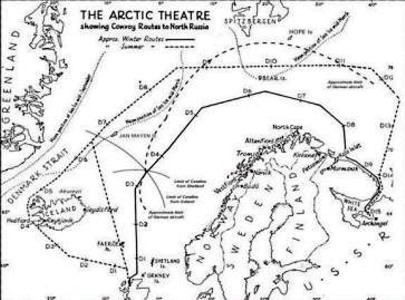
Narrative courtesy Dr. W. Alexander Douglas
